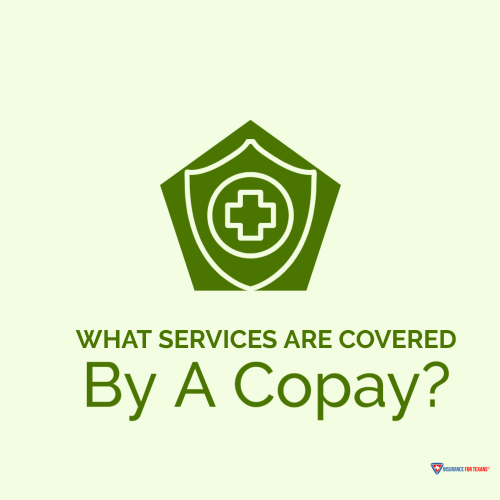When it comes to understanding the intricacies of health insurance, it's important to familiarize yourself with common terms and concepts. One such term is "copay." Copay is a very common term, but some Texans do not completely understand how it works or why it matters in the context of their health insurance plan. By understanding the role of a copay, you can make more informed decisions about your healthcare coverage and effectively manage your medical expenses.

A copay, or copayment, is a predetermined fixed amount that you are required to pay out of pocket for a specific healthcare service or prescription medication that is covered by your health plan. It is a form of cost sharing between you and your health insurance company, where you are responsible for a portion of the cost while the insurance company covers the remaining amount. Copays vary depending on the type of service or medication and are typically lower for routine services like doctor visits or generic drugs. Copays are usually paid at the time of service, ensuring immediate payment to the healthcare provider.
The purpose of a copay is twofold. First, it helps discourage unnecessary medical visits and services by requiring individuals to have some financial stake in their healthcare. Second, copays act as a predictable and manageable cost for policyholders, making it easier to budget for routine medical expenses. Unlike deductibles or coinsurance, copays are not typically subject to meeting a yearly limit or accumulating towards an out-of-pocket maximum. Thus, even if you have met your deductible and your health plan covers a service after coinsurance, you may still be responsible for a copay.
Now that we've established a copay is a fixed amount you pay for a specific health care service or medication, lets evaluate the different copays that come with different insurance plans.
Types Of Copays
Copays come in various types and options, allowing individuals to choose the level of cost sharing that best suits their needs. These variations can be determined by the insurance plan and the specific service being received. Understanding the different types of copays can help Texas adults navigate their health insurance options more effectively.
1. Fixed Copays: This is the most common type of copay, where a predetermined fixed amount is paid for a specific covered service or medication. For example, you might pay $20 for each office visit, regardless of the total cost of the visit.
2. Tiered Copays: Some insurance plans have different tiers for copays, usually for prescription drugs. The tiers are based on the medication's cost or classification, with lower copays for generic drugs and higher copays for brand-name or specialty drugs.
3. Percentage Copays: In certain cases, copays may be calculated as a percentage of the service cost rather than a fixed amount. For instance, you may be responsible for covering 20% of the total cost while your insurance covers the remaining 80%. This is not the same thing as coinsurance though.
4. Specialty Copays: These copays are specifically designed for certain specialized services or providers, such as visits to specialists, mental health services, or urgent care centers. They may have different copay amounts compared to regular doctor visits.
5. Wellness Copays: Some insurance plans offer copays that are either severely reduced or even waived entirely for preventive services like annual check-ups or vaccinations, emphasizing the importance of proactive healthcare. Affordable Care Act qualified plans have covered preventive services at no copay.
Remember to carefully review your insurance plan to determine what copays apply to the specific services you anticipate using most frequently whether that be an emergency room visit for your teen athlete or an urgent care visit for your youngest kiddo.
Common Questions About How To Manage A Copay On Your Health Insurance Plan
To help you navigate copays effectively, we will address some common questions, such as how to determine the cost of a copay, what happens if you can't afford a copay, and whether copays count towards your deductible. Read on to gain a better understanding of how to manage copays and make informed decisions about your health insurance plan.
How Copays Work With Health Insurance
Copays are a common feature in health insurance plans and play a crucial role in sharing the financial burden between the insurer and insured. When you visit a healthcare provider or receive medical services, you are typically required to pay a copay upfront at the time of service.
Copays are intended to discourage unnecessary use of medical facilities. By requiring individuals to pay a set amount out of pocket for each visit or service, it creates a financial disincentive for seeking care that may not be medically necessary. This ensures that healthcare services are used judiciously and prevents overutilization, which can strain healthcare resources.
How Much Is The Copay?
The health insurance plan will determine your copay amount looking at several factors. One of the primary factors that influence the copay amount is the type of care needed. Different services may have different copay amounts associated with them. For instance, the copay for a primary care doctor's visit may be lower compared to a specialty visit, such as seeing a specialist or visiting the emergency room.
The provider that you visit also plays a role in determining the copay. Health insurance plans typically have a preferred network of healthcare providers. If an individual visits a provider within this network, the copay amount may be lower compared to visiting an out-of-network provider. If you are covered by a PPO plan, the in network and out of network copays are likely different. If you are covered by a health Maintenance Organization, otherwise known as an HMO, going out of network will result in the service not being covered by your policy. This means that you will pay the full amount rather than a copay, and not have the cost count towards your annual deductible or maximum out of pocket for the year.
Overall, the copay amount in a health insurance plan is influenced by the type of care needed, the provider visited, and the specific insurance plan chosen. Understanding these factors and which copayment applies to you before you visit your health insurance provider can help Texans make informed decisions about their healthcare expenses.

What Services Are Covered By A Copay?
When determining which covered health care services have a copay, coinsurance, or are full pay until the deductible it is ultimately up to the policy terms of your plan. Here is a list of common health care services that are subject to copays.
Office visits with a primary care physician and specialist are often covered by a copay. This means that individuals will be responsible for paying a specific amount at the time of the visit, while the insurance company covers the remaining cost.
Prescriptions are typically covered by a tiered copay system. When individuals fill their prescriptions at a pharmacy, they will be required to pay a predetermined amount for each medication, with the insurance company covering the rest.
Therapy services such as physical therapy, occupational therapy, and speech therapy may also have copay requirements. These services typically involve ongoing sessions, and individuals may be required to pay a copay for each session. It's also not uncommon for this copay to be different from your primary care doctor.
Mental health in-office services, including visits to psychologists or psychiatrists, may also have copay amounts. Individuals seeking mental health support will need to pay a predetermined copay at each session, while the insurance company covers the remaining cost.
Additionally, in the event of an emergency, ambulance or emergency room services may also require a copay. It''s also important to note that these services commonly have a coinsurance provision after the copay if you have not met you annual deductible at the time of the event..
It's important to note that preventive care is generally exempt from copayments on qualified health plans. This means that services such as annual check-ups, vaccinations, and certain screenings are often covered in full without requiring individuals to pay a copay.
Copayments on health insurance plans can apply to a variety of covered health care services, including office visits, prescriptions, therapy, mental health services, and emergency care. It's essential for individuals to review their specific insurance plan and understand the copayment requirements for the services they may need.
Advantages And Disadvantages Of Having A Copay On Your Health Insurance Plan
When it comes to evaluating health insurance plans, it is important to understand the concept of copay and its impact on your healthcare expenses. While copays certainly have their advantages, they also come with a few disadvantages. Let's explore the benefits and drawbacks of having a copay on your health insurance plan, helping you make an informed decision about your coverage options in Texas.
Advantages of a copay on your plan
Having a copay on your health insurance plan can offer several advantages. One of the main benefits is the security and predictability it provides by setting fixed costs for certain services. With a copay, you know exactly how much you will have to pay out of pocket for each visit or service covered by your plan.
Copay plans also offer coverage for preventive care. This means that important screenings, vaccinations, and check-ups are often fully covered or require only a small copay. This can be especially beneficial for those who want to prioritize their overall health and wellness.
In addition, copay plans often include virtual doctor visits at no charge. This means you can seek medical advice without leaving the comfort of your home or office. Virtual visits can save you time and money, making it easier to access healthcare when you need it.
Copay plans provide several advantages, including security and predictability, coverage for preventive care, access to virtual doctor visits, and participation in wellness rewards programs. Considering these benefits can help you make an informed decision when evaluating your health insurance options.
Disadvantages of a copay on your plan
While there are several advantages to having a copay on your health insurance plan, there are also some disadvantages to consider. One downside is that copays can result in higher out-of-pocket costs for certain services, especially after expensive medical treatments or hospital visits. Plans designed with copays typically still require you to pay them even after you have met your out of pocket limits for the policy year. That means that you will still be required to make the copay after you have met that out of pocket max.
Another potential drawback of copay plans is limited coverage for certain services. While preventive care is typically covered or requires only a small copay, other services may have more restricted coverage. This could include alternative therapies, elective procedures, or certain medications that are not on the plan's approved list. It's important to carefully review the coverage details of your plan to ensure that it aligns with your specific healthcare needs.
It's also worth noting that copays can increase over time. Insurance companies may periodically adjust copay amounts, which could lead to higher out-of-pocket expenses for policyholders. Additionally, copay plans may have restrictions on seeing out-of-network providers. If you have a preferred doctor or specialist who is not in your plan's network, you may need to switch providers or pay higher out-of-pocket costs. This is especially true with HMO plans.
Overall, while copay plans offer predictability and convenience, they may also come with higher out-of-pocket costs, limited coverage, potential copay increases, and restrictions on provider choice. It's essential to carefully evaluate your healthcare needs and compare different plan options to determine which type of health insurance plan is best for you.
Tips For Maximizing Your Benefits From A Copay Plan
If you have a copay plan as part of your health insurance policy in Texas, there are several best practices you can follow to maximize its benefits and ensure you have adequate coverage for your healthcare needs.
1. Understand Copay Percentages: One key aspect of copay plans is the copay percentage, which determines the portion of the medical cost you are responsible for. By understanding these percentages, you can estimate your out-of-pocket costs and budget accordingly. Be sure to review the plan documents to see if copays are flat fees or a percentage of the total cost.
2. Utilize Preventive Care: Copay plans often cover preventive services with little or no copay required. Take advantage of these services, such as annual check-ups, screenings, and vaccinations, as they can help detect and prevent potential health issues before they become serious and costly.
3. Compare Premium Costs: When evaluating copay plans, compare their premiums with other general health insurance policies. While copay plans may have higher premiums, they generally provide more predictable out-of-pocket costs. Consider your healthcare needs and budget to determine if the higher premium is worth the added benefits after you think about how much health care you typically use through the course of a year.
4. Stay Within Network: To minimize out-of-pocket costs, seek healthcare services from providers within your plan's network. This ensures that you receive the maximum coverage allowed under your copay plan. If you have a preferred doctor or specialist, check if they are included in your network to make sure that you don't get caught by surprise.
5. Use Generic Drugs: Copay plans often provide coverage for prescription drugs. Whenever possible, opt for generic drugs as they are usually cheaper than brand-name alternatives. By choosing generic drugs, you can reduce your copay costs and save money on your medications.
By following these tips, you can make the most of your copay plan and ensure that you have affordable and comprehensive healthcare coverage. If you need help in evaluating plans or maximizing your plan choice, the independent insurance agents can help you understand what your options are with health insurance companies, the plans that they offer, and how they benefit you beyond just your monthly premium. Click the button below to get started with the professional advisors at Insurance For Texans.



